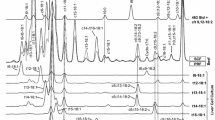Summary
23 adipoceres were chemically analyzed. They consisted of 50–95% fatty acids, of which 10–95% were saponified. Hydroxylated fatty acids constituted 0–28% and were identified as 10-monohydroxystearic acid by classical methods. Gas chromatography revealed further the presence of palmitic, stearic, oleic and myristic acid. In the majority of cases the acids were of the saturated types. Attempts to synthesize adipoceres were only partially successful (6 cases). In comparison with fresh material, there were interesting differences in the following: Fresh beef contained 16.2% fatty acids, fresh human tongue contained none. The synthesized adipocere from both, however, contained 83.7% and 91.4% fatty acids, respectively, proving the transformation of protein into fat. Saponified fatty acids were absent in fresh samples but present in adipocere thereof (0.6–14%) and similar to those in grave waxes. Saturated fatty acids were markedly increased. The formation of adipocere from fat tissue and protein tissue is indicated and its stabilization by saponification, saturation and hydroxylation. Adipocere formation is apparently caused by environmental factors and bacterial enzymes.
Zusammenfassung
Leichenwachsbildung wurde an 23 Fällen chemisch analysiert. Der Anteil der Fettsäuren betrug 50–95%, davon waren 10–95% Seifenfettsäuren. Für Hydroxy-fettsäure wurde ein Anteil von 0–28% festgestellt. Durch Elementaranalyse, Schmelzpunktbestimmung u. a. wurde sie als 10-Monohydroxyfettsäure identifiziert. Daneben ergaben sich bei der gaschromatographischen Analyse als Bestandteile Palmitin-, Stearin-, Olein-und Myristinsäure. In den meisten Proben entfiel der Hauptanteil auf gesättigte Fettsäuren. Versuche mit verschiedenen Materialien Leichenwachs künstlich herzustellen, gelangen in 6 Fällen, bei allen anderen wurden die Proben faulig und lösten sich auf. Ein Vergleich mit frischen Ausgangsstoffen ergab einige interessante Punkte. Der Fettsäureanteil belief sich bei frischem Rindfleisch auf 16,2% und bei frischer Menschenzunge auf 0%, dagegen betrug das Verhältnis bei dem daraus entstandenen Leichenwachs 83,7 bzw. 91,4%. Dies spricht eindeutig für eine Umwandlung von Eiweiß in Fett.
In frischen Proben wurden keine Seifenfettsäuren gefunden, im Leichenwachs jedoch Werte von 0,6 bis 14,1%. Die Zusammensetzung der Fettsäuren entsprach der in natürlichen Leichenwachs. Der Anteil gesättigter Fettsäuren war gegenüber frischen Materialien stark erhöht.
Als Entstehungsweise von Leichenwachs kommen in Frage: Stabilisierung der Fettsäure durch Verseifung, Sä ttigung ungesättigter Fettsäuren und Hydroxyfettsäurebildung. Verseifung ist ein Teilphänomen der Stabilisierung. Umwandlung von Eiweiß in Fett. Vermutlich werden diese Vorgänge durch Umweltbedingungen und bakterielle Enzyme ermöglicht.
Similar content being viewed by others
Literatur
Ascarelli, A.: Histologische Studien und bakteriologische Versuche über Adipocire. Vjschr. gerichtl. Med.32, 219 (1906).
Breed, R. S., Murray, E. G. D., Smith, N. R.: Bergey's manual of determinative bacteriology. Baltimore: Williams & Wilkins 1957.
Metcalfe, L. D., Schmitz, A. A.: The rapid preparation of fatty acid esters for gas chromatographic analysis. Analyt. Chem.33, 363–364 (1961).
Mita, S.: Tokyo Igakukai Zasshi22, 1049 (1908) (japanisch).
Mitsuki, K.: Histologische und histochemische Untersuchungen über das Leichenwachs. Tohoku J. exp. Med.76, 74 (1962).
Nanikawa, R., Okada, K., Kotoku, S., Yamada, T., Takagi, A., Ueda, M., Namba, H.: Studies on adipocere formation — Microorganismus isolated from natural and experimental adipoceres. J. Yonago med. Ass.15, 452 (1964) (japanisch mit englischer Zusammenfassung).
Nanikawa, R., Tawa, N., Saito, K.: Chemical studies on adipocere formation. Jap. J. Legal Med.15, 258 (1961).
Prokop, O.: Forensische Medizin. Berlin: VEB Verlag Volk und Gesundheit 1966.
Ruttan, R. F., Marshall, M. J.: The composition of adipocere. J. biol. Chem.29, 319 (1917).
Smith, S., Fiddes, F. S.: Forensic medicine. Boston: Little Brown & Company 1955.
Walcher, K.: Die späteren Leichenveränderungen — Leichenwachs. Ergebn. allg. Path. Anat.33, 126 (1937).
Author information
Authors and Affiliations
Additional information
Herrn Prof. B. Mueller zum 75. Geburtstag gewidmet.
Rights and permissions
About this article
Cite this article
Nanikawa, R. Über die Bestandteile von natürlichen und experimentell hergestellten Leichenwachsen. Z Rechtsmed 72, 194–202 (1973). https://doi.org/10.1007/BF02079407
Received:
Issue Date:
DOI: https://doi.org/10.1007/BF02079407




